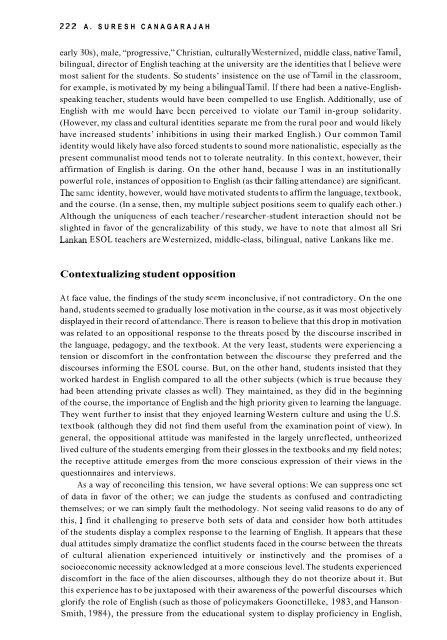English Language Teaching in its Social Context
English Language Teaching in its Social Context
English Language Teaching in its Social Context
You also want an ePaper? Increase the reach of your titles
YUMPU automatically turns print PDFs into web optimized ePapers that Google loves.
222 A. SURESH CANAGARAJAHearly OS), male, “progressive,” Christian, culturally Westerniied, middle class, nativeTamil,bil<strong>in</strong>gual, director of <strong>English</strong> teach<strong>in</strong>g at the university are the identities that I believe weremost salient for the students. So students’ <strong>in</strong>sistence on the use ofTamil <strong>in</strong> the classroom,for example, is motivated by my be<strong>in</strong>g a bil<strong>in</strong>gualTamil. If there had been a native-<strong>English</strong>speak<strong>in</strong>gteacher, students would have been compelled to use <strong>English</strong>. Additionally, use of<strong>English</strong> with me would havc been perceived to violate our Tamil <strong>in</strong>-group solidarity.(However, my class and cultural identities separate me from the rural poor and would likelyhave <strong>in</strong>creased students’ <strong>in</strong>hibitions <strong>in</strong> us<strong>in</strong>g their marked <strong>English</strong>.) Our common Tamilidentity would likely have also forced students to sound more nationalistic, especially as thepresent communalist mood tends not to tolerate neutrality. In this context, however, theiraffirmation of <strong>English</strong> is dar<strong>in</strong>g. On the other hand, because I was <strong>in</strong> an <strong>in</strong>stitutionallypowerful role, <strong>in</strong>stances of opposition to <strong>English</strong> (as their fall<strong>in</strong>g attendance) are significant.The same identity, however, would have motivated students to affirm the language, textbook,and the course. (In a sense, then, my multiple subject positions seem to qualify each other.)Although the uniqueness of each teacher/researcher-student <strong>in</strong>teraction should not beslighted <strong>in</strong> favor of the gcncralizability of this study, we have to note that almost all SriLankan ESOL teachers are Westernized, middlc-class, bil<strong>in</strong>gual, native Lankans like me.<strong>Context</strong>ualiz<strong>in</strong>g student oppositionAt face value, the f<strong>in</strong>d<strong>in</strong>gs of the study seem <strong>in</strong>conclusive, if not contradictory. On the onehand, students seemed to gradually lose motivation <strong>in</strong> the course, as it was most objectivelydisplayed <strong>in</strong> their record of attcndance.There is reason to believc that this drop <strong>in</strong> motivationwas related to an oppositional response to the threats posed by the discourse <strong>in</strong>scribed <strong>in</strong>the language, pedagogy, and the textbook. At the very least, students were experienc<strong>in</strong>g atension or discomfort <strong>in</strong> the confrontation between the discoursc they preferred and thediscourses <strong>in</strong>form<strong>in</strong>g the ESOL course. But, on the other hand, students <strong>in</strong>sisted that theyworked hardest <strong>in</strong> <strong>English</strong> compared to all the other subjects (which is true because theyhad been attend<strong>in</strong>g private classes as well). They ma<strong>in</strong>ta<strong>in</strong>ed, as they did <strong>in</strong> the beg<strong>in</strong>n<strong>in</strong>gof the course, the importance of <strong>English</strong> and the high priority given to learn<strong>in</strong>g the language.They went further to <strong>in</strong>sist that they enjoyed learn<strong>in</strong>g Western culture and us<strong>in</strong>g the U.S.textbook (although they did not f<strong>in</strong>d them useful from the exam<strong>in</strong>ation po<strong>in</strong>t of view). Ingeneral, the oppositional attitude was manifested <strong>in</strong> the largely unrcflected, untheorizedlived culture of the students emerg<strong>in</strong>g from their glosses <strong>in</strong> the textbooks and my field notes;the receptive attitude emerges from the more conscious expression of their views <strong>in</strong> thequestionnaires and <strong>in</strong>terviews.As a way of reconcil<strong>in</strong>g this tension, we have several options: We can suppress one setof data <strong>in</strong> favor of the other; we can judge the students as confused and contradict<strong>in</strong>gthemselves; or we can simply fault the methodology. Not see<strong>in</strong>g valid reasons to do any ofthis, 1 f<strong>in</strong>d it challeng<strong>in</strong>g to preserve both sets of data and consider how both attitudesof the students display a complex response to the learn<strong>in</strong>g of <strong>English</strong>. It appears that thesedual attitudes simply dramatize the conflict students faced <strong>in</strong> the course between the threatsof cultural alienation experienced <strong>in</strong>tuitively or <strong>in</strong>st<strong>in</strong>ctively and the promises of asocioeconomic necessity acknowledged at a more conscious level. The students experienceddiscomfort <strong>in</strong> the face of the alien discourses, although they do not theorize about it. Butthis experience has to be juxtaposed with their awareness of the powerful discourses whichglorify the role of <strong>English</strong> (such as those of policymakers Goonctilleke, 1983, and Hanson-Smith, 1984), the pressure from the educational system to display proficiency <strong>in</strong> <strong>English</strong>,












